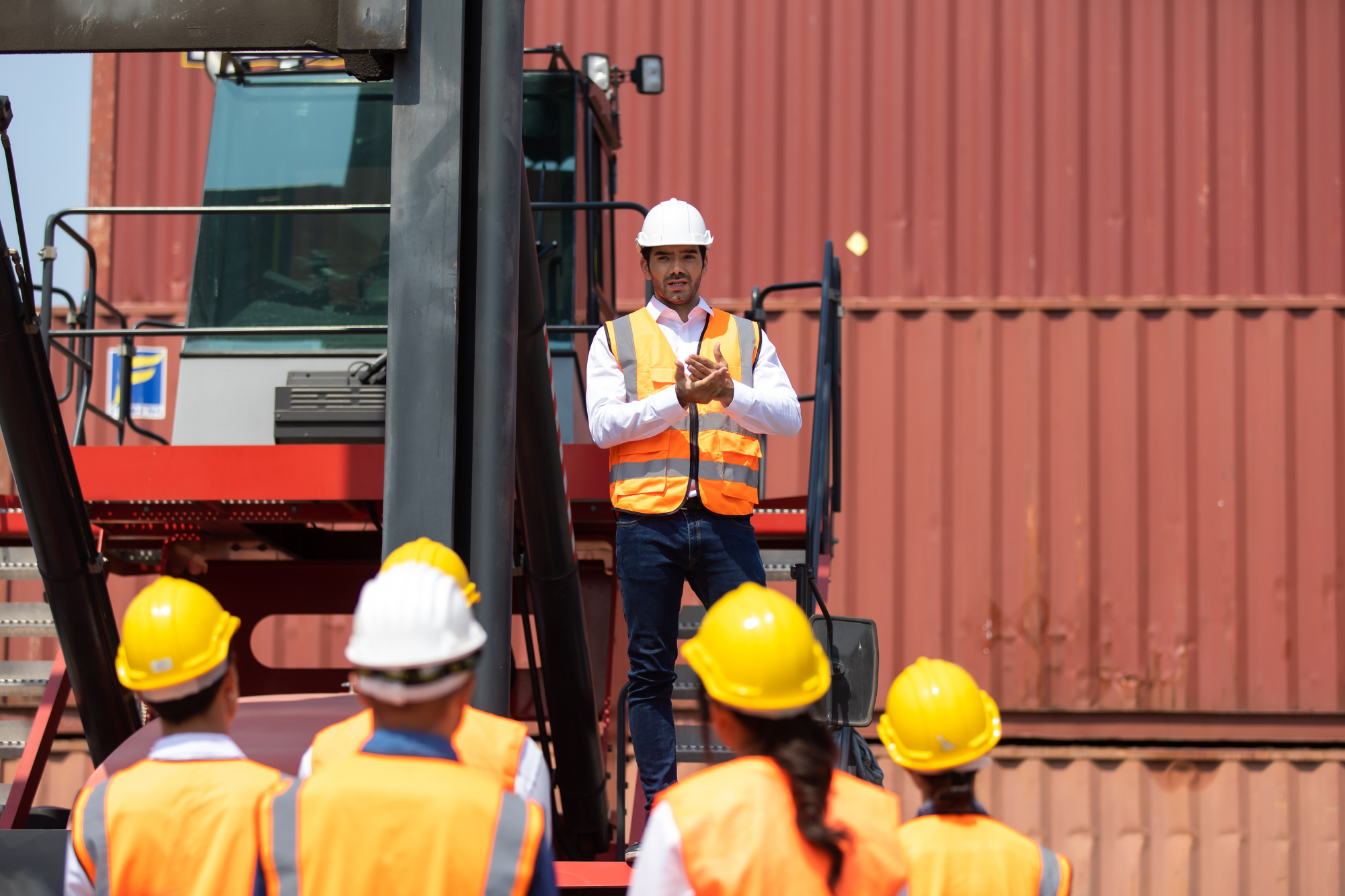
Toolbox talks: How to maximize impact and improve workplace safety
The role of toolbox talks in safety culture
A toolbox talk is a short, focused conversation designed to quickly deliver safety and health guidance to workers—without adding more to your plate. Typically led by a supervisor, these informal huddles highlight a specific hazard or safe work practice relevant to that day’s tasks.
As an EHS leader, you’re constantly looking for ways to reinforce safety without slowing down operations. Toolbox talks can be one of your best tools for building a safety culture, reinforcing training, and boosting frontline engagement.
Sometimes called tailgate talks, these sessions differ from formal safety training. They’re direct, informal, and designed to cut through the noise—no slides, no handouts—just clear, meaningful communication with your team.
The business case for better toolbox talks
Toolbox talks don’t replace formal training, but they play a critical role in reinforcing key safety messages and habits. By addressing a single, specific topic—such as using a particular tool safely or identifying a job site hazard—toolbox talks provide real-time relevance.
Improving the quality of toolbox talks can have measurable business benefits, such as:
- Fewer incidents and injuries: Toolbox talks reinforce safety behaviors that reduce the frequency and severity of workplace incidents. Research shows that safety training involving dialogue, hands-on practice, and behavioral modeling—like toolbox talks—tends to be more effective than passive, computer-based formats. When employees are actively engaged, they’re more likely to recognize hazards and apply safe work practices on the job.
- Lower costs: Workplace injuries and illnesses impose significant financial burdens on employers. It’s estimated that employers pay nearly $1 billion per week for direct workers’ compensation costs alone. Implementing effective toolbox talks can help reduce these expenses by preventing incidents before they occur.
- Improved compliance: Maintaining documentation of toolbox talks helps support regulatory requirements and demonstrates a commitment to safety during audits or inspections.
Common challenges
Understanding the obstacles that can undermine your toolbox talks is the first step toward making them more effective. Addressing these challenges head-on can help turn a routine discussion into a meaningful part of your safety culture.
Poor scheduling and planning
Schedule toolbox talks at the start of a shift or immediately after a break—times when employees are most alert and ready to focus. Choose a spot that’s near the job site but free from distractions. A familiar, comfortable setting promotes better attention and encourages open dialogue.
Irrelevant topics
If the subject doesn’t relate to the work at hand, employees may tune out. Make every talk count by aligning it with current tasks, site-specific risks, seasonal changes, or lessons learned from recent incidents. When your team sees the relevance, they’re more likely to listen, ask questions, and apply the information in real time.
Lack of time or resources
Toolbox talks are most effective when they’re thoughtfully integrated into daily or weekly routines. Failing to plan for them in your schedule or budget can diminish their effectiveness. Build time into the day and assign a knowledgeable speaker—someone who can prepare, speak clearly, and connect with the team. Even small, consistent investments in preparation lead to stronger outcomes.
Tips to make your toolbox talks more effective
Keep it brief
Aim for 5–10 minutes once per shift, or at minimum, weekly. Increase frequency when hazards or conditions change.
Leave time for questions
It’s common for employees to have questions—especially when a new process rolls out or a new piece of equipment is added to the job site.
Open the floor for questions at the end. Whether you’re introducing a new tool, process, or seasonal hazard, providing time for discussion builds trust and encourages your team to speak up, seek clarity, and perform their work with confidence.
Make it engaging
Engagement starts with how the message is delivered. Use a conversational tone, maintain eye contact, and tie the message to real work conditions. A strong delivery turns a routine talk into a moment of connection—and reinforces that safety is a shared value.
Encourage participation
Invite your team to contribute by asking open-ended questions, sharing their own stories, or offering observations from the field. When more experienced team members speak up, it adds real-world credibility and helps newer employees learn through lived experience. Participation encourages deeper learning, reveals hidden risks, and strengthens team accountability. Most importantly, it shows that every voice matters in building a safer workplace.
Show what “safe” looks like
Use visual demonstrations whenever possible and add a “show and tell” component. Whenever possible, stand next to the equipment or in the actual work area to demonstrate safe procedures. For example, when presenting on ladder safety, stand at the ladder and demonstrate proper usage. This hands-on, “show and tell” approach helps employees see exactly how the safety message applies to their tasks and surroundings.
End with a simple and clear takeaway
Wrap up each toolbox talk with a clear, memorable phrase that captures the core message. A strong closing helps reinforce the learning and gives your team a simple reminder they can carry with them throughout the shift.
Pro tip: Invite the team to contribute or come up with their own safety slogans during future talks or hold a ‘safety slogan showdown’ – you can even make it a friendly competition and offer incentives. Taking small steps toward more engaging toolbox talks and trainings can go a long way.
The EHS leader’s role in ensuring toolbox talk effectiveness
EHS and safety leaders are instrumental in shaping the effectiveness of toolbox talks—not by leading every session themselves, but by equipping frontline supervisors and managers to deliver them with consistency, clarity, and purpose. These brief conversations serve as powerful touchpoints for reinforcing safe behaviors, identifying risks early, and keeping safety visible on the job site.
When you champion the importance of meaningful, task-relevant talks—and provide the right tools, structure, and expectations—your teams are more likely to lead sessions with care and consistency.
The involvement of an EHS leader ensures topics align with current site conditions, operational goals, and regulatory priorities. Whether you’re reviewing materials, offering talking points, or auditing delivery, your support reinforces that these talks are more than a formality—they’re a core part of your organization’s safety culture.
Encourage ongoing reinforcement through shift briefings, safety huddles, or one-on-one follow-ups. These short touchpoints keep key messages active and integrated into the workday—turning brief talks into sustained awareness.
Lastly, accurate recordkeeping supports compliance and shows your commitment to a proactive safety program. Each toolbox talk should include a log of the date, time, topic, location, attendees, and any feedback or follow-up actions. These records not only meet regulatory expectations but also help identify patterns and areas for improvement over time.
A one-stop solution for busy safety professionals
BLR’s Safety Toolbox Trainer is your trusted solution for planning and delivering impactful toolbox talks—wherever work happens. Whether you’re leading a quick safety huddle in the field or coordinating training across multiple sites, this intuitive platform helps you stay organized, consistent, and compliant.
With access to more than 250 ready-to-deliver topics—each complete with lesson plans, handouts, and quizzes in both English and Spanish—you can select relevant content that aligns with daily tasks, site conditions, or seasonal hazards. The mobile app allows you to conduct talks on site, even without internet access, and track attendance, notes, and safety observations in real time.
Safety Toolbox Trainer supports your commitment to a proactive safety culture by making toolbox talks easier to schedule, deliver, and document—so you can focus on what matters most: engaging your team, reinforcing safe behaviors, and creating a workplace where safety is part of every conversation.



